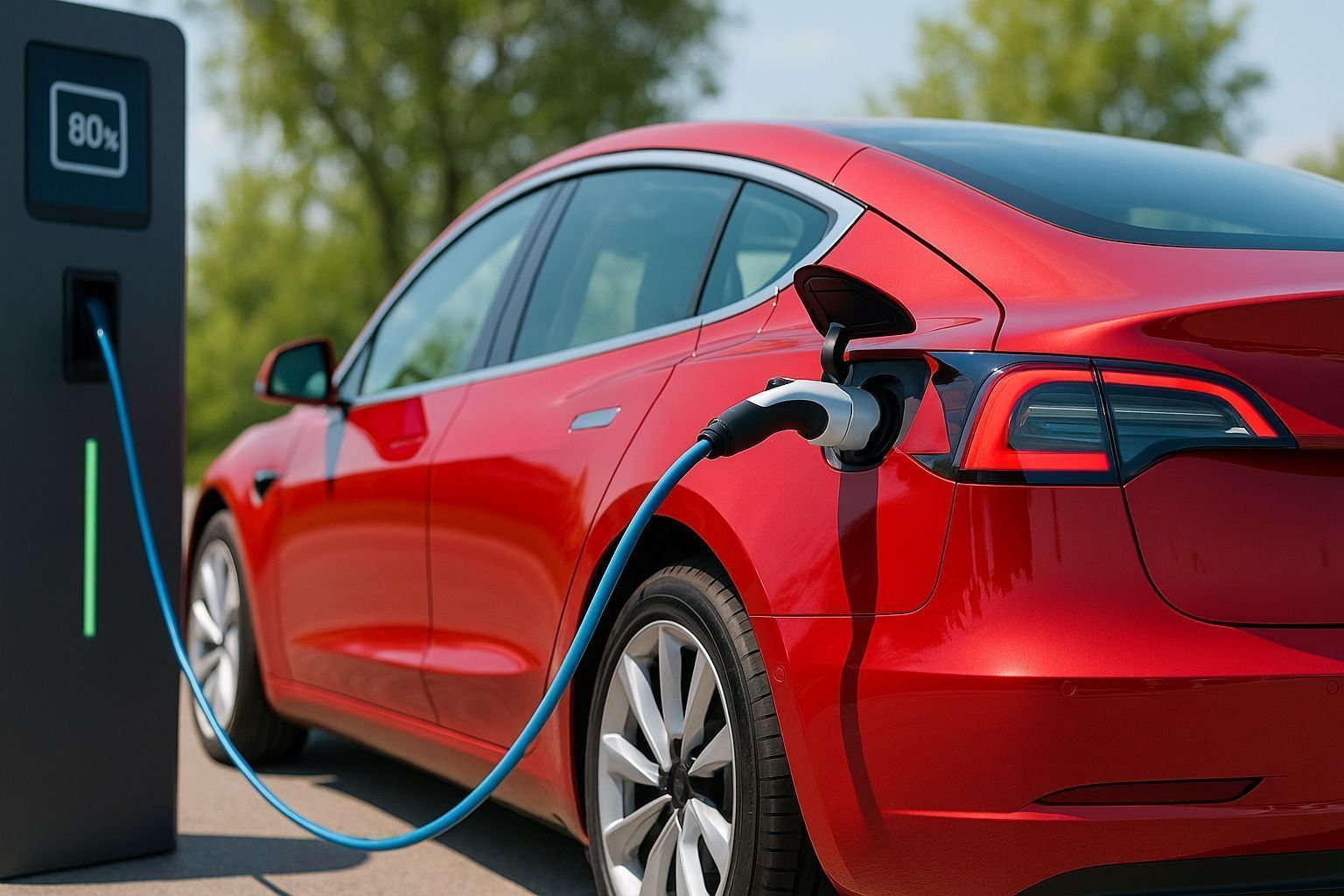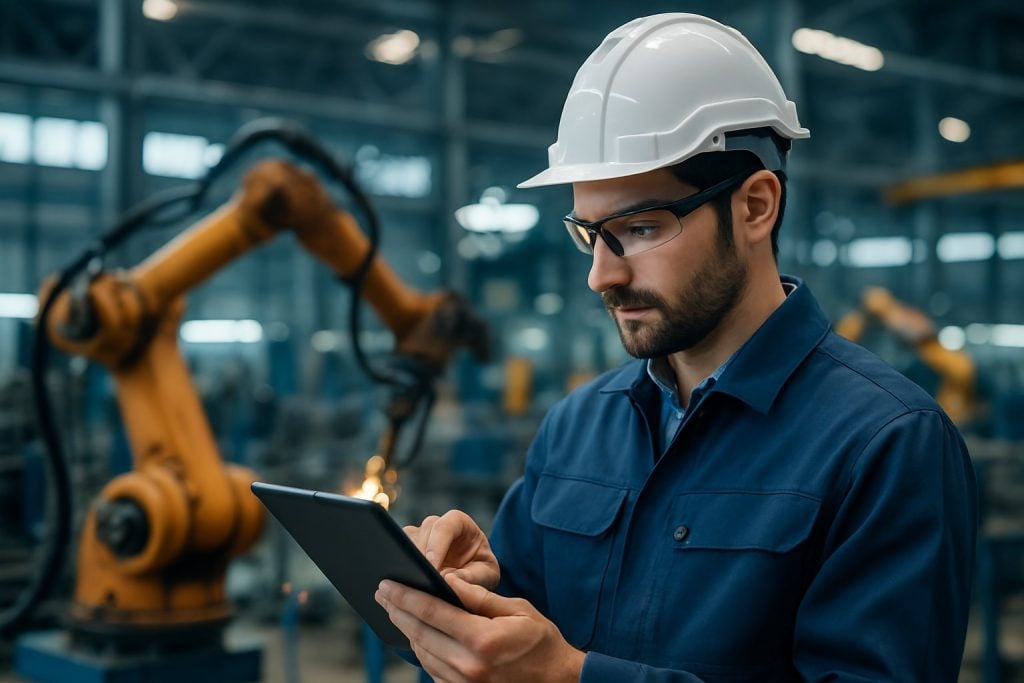- BYD field-tested solid-state EV batteries with nearly 400 Wh/kg energy density, enabling about 1,500 km ranges on a 12-minute (80%) charge, with prototypes in real cars and aims for industrial scale by 2030.
- Nissan plans its first solid-state EV in 2028 as part of a broader industry push including Mercedes-Benz, Volkswagen, CATL, and Stellantis.
- Kalmar (Cargotec) launched a second-generation Li-ion battery system for heavy electric forklifts and port equipment, delivering 10 hours of operation and improved thermal stability.
- Global EV sales through May 2025 reached 7.2 million units, with China contributing 4.4 million and May 2025 alone at 1.0 million, while Europe grew about 27% YTD and North America roughly 3%.
- UK’s AESC Sunderland gigafactory received £1 billion funding to supply batteries for up to 100,000 EVs per year, backed by the UK government and private financing, six-folding Britain’s EV battery output.
- In Switzerland, an 800 MW / 1,600 MWh vanadium redox flow battery is planned for a data center at Laufenburg, expected to be the world’s largest when commissioned in 2028.
- Aramco commissioned a 1 MW / 1 MWh iron-vanadium flow battery in May to power remote gas wells with solar, operating from –8°C to 60°C without cooling and eliminating diesel use.
- NREL-backed ARPA-E project advances a sand-based thermal storage system using hot silica sand, with pilots considered by the New York Power Authority and Toronto planners for multi-day storage and district heating.
- CATL launched the sodium-ion battery brand “Naxtra” with mass production planned for December 2025, offering about 175 Wh/kg and 80% charge in 15 minutes, potentially replacing up to half of LFP batteries.
- EU device battery eco-labeling rules, effective June 20, 2025, require 800 full charge cycles to ≥80% capacity, 7 years repairability, 5 years software support, and are projected to save around 14 TWh energy and 46 million tons CO2 by 2030.
June–July 2025 saw significant advances in battery technology and energy storage worldwide, spanning electric vehicles (EVs), grid-scale systems, and consumer electronics. This report compiles the latest news, industry forecasts, R&D breakthroughs, expert insights, and policy changes from this period, highlighting how batteries continue to transform transportation, power grids, and devices.
Electric Vehicles: Battery Innovations and Market Trends
- Solid-State and High-Range EV Batteries: In early July, China’s BYD revealed it is field-testing solid-state EV batteries with nearly 400 Wh/kg energy density – about double current lithium-ion cells – enabling 1,500 km range on a 12-minute (80%) charge Noticiasambientales. BYD’s technical director confirmed prototypes are running in real cars (model undisclosed) and aims for industrial scale by 2030 Noticiasambientales Noticiasambientales. This would far exceed today’s EV ranges (with ~1,300 km under stricter EPA tests). The global race for solid-state leadership includes Nissan (planning its first solid-state EV in 2028) and active R&D programs at Mercedes-Benz, Volkswagen, CATL, and Stellantis, among others Noticiasambientales. While solid-state promises safer, higher-capacity batteries, commercialization remains in progress – initial “semi-solid” batteries (hybrid electrolyte designs) are expected around 2027–2028 Sustainability Times.
- Advanced Lithium-Ion for EVs: Traditional lithium-ion technology also saw improvements. Finland’s Kalmar (Cargotec) launched a second-generation Li-ion battery system for heavy electric forklifts and port equipment. The new battery packs offer greater energy capacity, 10-hour operation in heavy-duty use, and improved thermal stability for hot climates Batteriesnews Batteriesnews. This enables industrial EVs (e.g. electric reachstackers) to run longer without compromising safety. Kalmar’s VP called it “a major step forward” in enabling fully electric fleets with enhanced safety, longer lifespan, and predictable performance Batteriesnews.
- Global EV Sales Surge: The EV market accelerated through mid-2025. Global EV sales reached 7.2 million units from January–May, up 28% year-on-year Electrek. China alone contributed 4.4 million (a record 1.0 million EVs sold in May 2025) – a 33% YoY jump, highlighting China’s dominance Electrek. Europe also saw robust growth (+27% YTD), with Spain (+72%) and Italy (+58%) leading percentages Electrek. In contrast, North America’s EV sales grew only ~3% amid reduced incentives in some regions Electrek Electrek. Industry forecasts remain optimistic: the IEA projects over 20 million electric cars sold worldwide in 2025 (>25% of all new cars), a ~25% annual increase Iea. Major policy moves are underpinning this trend – for example, Germany rolled out new tax breaks for corporate EV fleets, expected to “supercharge” sales in coming months Electrek.
- Battery Manufacturing Investments: Automakers and governments announced hefty investments to scale battery production. In the UK, a £1 billion ($1.3B) funding deal was approved in May for a new AESC gigafactory in Sunderland Reuters. This Japanese-led plant (in partnership with Nissan) will supply batteries for up to 100,000 EVs/year – a six-fold increase in Britain’s EV battery output Reuters. The project is backed by the UK government (via its wealth fund and export finance guarantees) alongside private financing Reuters Reuters, bringing hundreds of skilled jobs. AESC’s CEO said the investment is “a key milestone” toward U.K. decarbonization and EV market growth Reuters. Similar capacity expansions are underway globally as manufacturers race to meet surging EV demand and secure regional supply chains.
Grid-Scale Storage and Renewable Integration
- Record-Breaking Flow Battery Projects: Long-duration energy storage made headlines in June with projects dwarfing previous installations. In Switzerland, authorities approved construction of an 800 MW/1,600 MWh vanadium redox flow battery system – poised to be the world’s largest when commissioned in 2028 Energy Storage. The project, part of a data center in Laufenburg, will vastly exceed Europe’s current flow batteries (only low-double-digit MWh scale) Energy Storage. Developers cite flow technology’s economics of scale: “a flow battery gets less pricey if you make it bigger…with long durability, it becomes comparable to cheaper lithium-ion for 8–10+ hour storage” Energy Storage. They aim to demonstrate flow batteries’ benefits (non-flammable, nearly limitless cycling) at a scale on par with large lithium-ion farms Energy Storage, addressing Europe’s need for safe multi-hour storage to balance renewable power.
- Oil Industry Adopts Flow Storage: In a world-first deployment, Aramco (Saudi Arabia) commissioned a 1 MW/1 MWh iron-vanadium flow battery in May to power remote gas wells with solar energy Esgnews. Co-developed with China’s Rongke Power, this Fe/V flow system operates reliably in extreme desert conditions (–8°C to 60°C without cooling) and eliminates fire risk, providing a durable alternative to lead-acid batteries for off-grid sites Esgnews. Aramco’s technology chief hailed it as a “ground-breaking… flexible solution for diverse renewable storage needs”, noting it supports the company’s net-zero 2050 goals by cutting diesel generator use Esgnews Esgnews. The flow battery stores solar power in liquid electrolytes (iron/vanadium redox pairs), enabling countless charge cycles with minimal degradation Esgnews. This successful pilot in the oil & gas sector underscores the growing role of advanced batteries in industrial decarbonization and resilient energy supply.
- Thermal Energy Storage Innovations: Beyond electrochemical batteries, researchers are advancing novel storage methods for integrating renewables. At the U.S. NREL, an ARPA-E backed team developed a sand-based thermal storage system that’s now attracting commercial interest Solarpaces Solarpaces. The concept repurposes retired coal plant infrastructure: surplus electricity heats silica sand stored in insulated silos, and the heat can later drive steam turbines to generate power Solarpaces. Utilities like the New York Power Authority and urban planners in Toronto are exploring using “hot sand” tanks to provide multi-day storage and even district heating Solarpaces. Sand is cheap, abundant, non-toxic, and stable up to ~1400°C, making it an appealing medium for long-duration energy storage with minimal capacity fade Solarpaces Solarpaces. Such solutions could complement batteries: while lithium batteries excel at short-duration grid balancing, thermal storage offers a cost-effective way to “park” excess solar/wind energy for days Solarpaces, increasing grid resilience as renewables grow.
- Multi-Chemistry Approaches: Established battery makers are also diversifying into grid storage technologies beyond Li-ion. For instance, companies like CATL and Tesla are reportedly investing in iron-air batteries and large-scale flow systems for stationary storage, aiming for lower-cost, longer-duration solutions to back up renewable-heavy grids Sustainability Times. Iron-air batteries (which “inhale” oxygen to induce rust and later reverse it) can theoretically provide 100+ hours of storage at very low cost, while flow batteries allow easy expansion of energy capacity by simply adding more electrolyte Sustainability Times. These efforts, alongside emerging startups, illustrate a broad industry push to address the <10-hour storage gap and ensure renewable energy is available on demand.
Consumer Electronics Battery Advances
- Higher-Capacity Phone Batteries: Smartphone makers are poised to leap ahead in battery capacity thanks to materials innovation. Silicon-carbon anode technology – already used by many Chinese OEMs – is enabling much higher mAh within the same battery size. Current silicon-infused Li-ion cells (~10% silicon in the anode) have allowed phones with 6,000–7,000 mAh batteries without excessive bulk Androidheadlines. Next-generation designs will double the silicon content to ~20%, yielding single-cell phone batteries around 9,000 mAh capacity Androidheadlines Androidheadlines. This could arrive in upcoming flagship phones, delivering multi-day battery life without making devices larger or heavier. Notably, brands like Oppo, Xiaomi, OnePlus, and Honor have led in adopting silicon-augmented batteries, while Apple, Samsung, and Google are expected to follow as the tech matures Androidheadlines. By packing more silicon (which has ~10x the lithium storage capacity of graphite) into anodes, manufacturers can radically boost energy density – albeit managing silicon’s expansion remains a key challenge. These advances address consumer demands for longer battery life to support power-hungry apps and AI features.
- Battery Labeling and Longevity Standards: New regulations in the EU aim to improve transparency and lifespan of consumer device batteries. Starting June 20, 2025, all smartphones and tablets sold in the EU must carry a battery eco-label detailing their battery endurance and efficiency Itc. The label (similar to appliance energy ratings) will report metrics like expected battery life after a set number of charge cycles. Importantly, the EU now requires that phone batteries survive at least 800 full charge cycles with ≥80% of original capacity Itc – roughly equivalent to 3+ years of typical use – as a minimum durability standard. Manufacturers must also improve repairability (providing spare batteries and parts for 7 years after model sale) and guarantee software support for 5 years Itc. These rules, part of a broader eco-design initiative, aim to curb electronic waste and inform consumers, potentially saving an estimated 14 TWh of energy and 46 million tons CO₂ by 2030 through longer-lasting devices Itc Itc. While the mandate is EU-only, its impact is global – phone makers are unlikely to create region-specific designs, so buyers worldwide should benefit from more robust batteries and transparency. (Already, Europe’s upcoming battery regulations also push for user-replaceable batteries in devices by 2027, further emphasizing longevity.)
Breakthroughs in Battery R&D and Alternative Chemistries
- Sodium-Ion Batteries Enter the Market: Once a lab curiosity, sodium-ion (Na-ion) batteries made significant strides toward commercialization in mid-2025. China’s battery giant CATL launched a new sodium-ion battery brand “Naxtra”, with mass production slated for December 2025 Reuters. CATL’s first Naxtra cells will offer ~175 Wh/kg energy density – nearly on par with common LFP (lithium iron phosphate) cells Reuters – and can charge to 80% in 15 minutes even in cold weather Reuters. Sodium, being cheap and abundant, could cut costs once supply chains scale, and CATL’s founder has said Na-ion could eventually replace up to half of LFP batteries Reuters. Other Chinese players like HiNa Battery have also unveiled second-generation Na-ion packs with improved density and fast charging Sustainability Times. Despite progress, Na-ion EV batteries still trail lithium-based ones in performance – current Na-ion cells have lower range and cycle life, and in China they cost nearly 2× an equivalent LFP pack Spglobal Spglobal. This economics gap has even forced some Western Na-ion startups to pivot or shut down Spglobal. Still, Na-ion excels in cold climates (retaining charge in subzero conditions better than Li-ion) Sustainability Times and avoids expensive minerals (lithium, cobalt, nickel). In coming years, analysts expect Na-ion to find niches in stationary storage and low-cost EVs – especially if lithium prices spike again or a breakthrough boosts Na-ion energy density closer to lithium’s Spglobal Spglobal.
- Lithium-Sulfur and Next-Gen Lithium Chemistries: Researchers are also pursuing lithium-sulfur (Li-S) batteries as a lighter, cheaper alternative. Li-S cells use abundant sulfur in place of nickel or cobalt, potentially achieving theoretical energy densities 2–3× Li-ion. In 2025, companies like Lyten (a U.S. startup) and automaker Stellantis announced plans to scale up lithium-sulfur – with pilot production facilities and joint ventures aiming to deliver “lighter, cheaper” EV batteries in coming years Sustainability Times. Li-S promises high mass-specific energy (gravimetric density) and avoids critical minerals, but faces challenges: low volumetric energy (bulky cells), limited cycle life, and safety issues with polysulfide shuttling Sustainability Times. Progress is steady – Lyten claims its proprietary Li-S chemistry (using a 3D graphene-based cathode) can reach energy parity with Li-ion while lasting hundreds of cycles, sufficient for drones, aerospace, and eventually EVs. Meanwhile, cobalt-free lithium-ion variants are advancing: in Europe, Morrow Batteries (Norway) partnered with Sweden’s SEEL lab under an IPCEI program to develop LNMO cells (lithium nickel manganese oxide cathodes) Batteriesnews. LNMO offers high voltage and eliminates cobalt; the Morrow-SEEL team is creating accelerated aging tests to optimize lifespan and safety so these next-gen cells can reach market faster Batteriesnews. Such collaborations aim to strengthen Europe’s battery value chain with innovative chemistries that reduce supply risks (cobalt) and improve performance.
- Recycling and Second-Life: Alongside new chemistries, the industry is investing in battery recycling and reuse. A notable development in July was Ecobat, a global battery recycler, completing the sale of its Italian branch to Haiki – part of an ongoing consolidation in the recycling sector Batteriesnews. Governments are also mandating recycling: the EU’s Battery Regulation (approved 2023) will soon require minimum recycled content in new batteries and a “battery passport” to track each battery’s lifecycle by 2026. These initiatives, coupled with innovations in recycling processes, aim to ensure that today’s battery boom remains sustainable, recovering valuable materials like lithium, nickel, and vanadium for reuse. Industry experts note that robust recycling could mitigate raw material shortages and reduce the environmental footprint of battery manufacturing – an area of active R&D in 2025.
Market Outlook and Policy Updates
- Market Forecasts: Analysts remain bullish on the energy storage market across sectors. A GlobeNewswire report projected the next-gen advanced battery market (covering solid-state, Na-ion, etc.) will surge from $1.5 billion in 2024 to $5.3 billion by 2029 (28.5% CAGR) Globenewswire, reflecting rapid commercialization of new battery types. For EVs specifically, BloombergNEF and the IEA predict over 20 million sales in 2025 and continuing growth through the decade as battery costs fall and policy support grows Iea. One emerging trend is the diversification of battery supply: China still leads in cell production (70%+ share), but Europe and North America have dozens of gigafactories planned or under construction through 2030 Globenewswire. This geographic expansion is attracting massive investments – e.g. Toyota’s $8B expansion of its North Carolina battery plant (announced late 2023) to 30 GWh/year capacity Batterytechonline, or Indonesia’s ongoing projects to become a major battery hub leveraging its nickel resources. Investment in energy storage projects (batteries for the grid) is also climbing; the U.S. Department of Energy’s latest funding round (mid-2025) under programs like ARPA-E and the bipartisan infrastructure law is directing billions into novel storage demonstrations, from flow batteries to ultra-cheap iron-based chemistries.
- Expert Commentary: Industry leaders stress that innovation and scale are driving the battery boom. Charles Lester of Rho Motion highlighted the contrast in EV markets – “the continued chasm between Chinese market growth…versus the faltering market in North America” – noting policy as a key factor Electrek. European battery executives, meanwhile, emphasize scaling up alternative chemistries to compete with entrenched lithium-ion. A spokesperson for the 1.6 GWh Swiss flow project said “it’s about time we introduce [flow batteries] at a bigger scale to Europe”, citing their non-flammability and longevity as ideal for long-term storage needs Energy Storage Energy Storage. Similarly, Morrow’s Chief Science Officer in Norway stated that partnering with testing labs like SEEL “allows us to move faster and deliver better battery solutions…a practical step towards a stronger European battery industry” Batteriesnews Batteriesnews. Experts also caution about raw material challenges – e.g. the S&P Global report “So near and yet so far” on sodium-ion concluded that unless lithium prices stay high or energy density improves, Na-ion will struggle to undercut Li-ion in EVs Spglobal Spglobal. Such insights underscore that while breakthroughs are coming fast, economics and policy will determine how they scale.
- Regulatory Shifts: Governments continued to refine policies to support battery adoption and sustainability. Besides the EU’s device battery rules mentioned, Europe’s broader Battery Regulation is rolling out measures like mandatory recycled content (e.g. 16% cobalt, 6% lithium in new batteries by 2030) and carbon footprint disclosures for large batteries, affecting designs from 2025 onward Circularise Cicenergigune. In the U.S., the Treasury and Department of Energy in June clarified EV tax credit rules around battery sourcing, influencing supply chains for critical minerals. China, for its part, extended NEV (New Energy Vehicle) purchase incentives and is investing heavily in domestic mining/refining to secure lithium and rare earths. And in a symbolic step toward standardization, India adopted battery safety and performance norms in line with UN standards this July, aiming to improve EV battery reliability after past fire incidents. These regulatory actions globally are pushing the industry toward safer, more sustainable batteries – from requiring easy consumer battery replacement to ensuring ethical sourcing of materials – ensuring that the battery revolution delivers long-term societal benefits.
Sources: The information above is drawn from industry news outlets, analyst reports, and official announcements in June–July 2025. Key references include Reuters, Electrek, S&P Global Mobility, Sustainability Times, BatteryTechnology Online, Energy-Storage.news, ESG News, and others, as cited throughout Reuters Electrek Itc Esgnews. These developments together paint a picture of an accelerating battery ecosystem – one that is rapidly evolving through technological innovation, scaling up via investments, and being steered by strategic policies toward a more electrified and sustainable future.




